#Tsukiyomi prototype designs
Text
Capri’s Guide to Sho Minazuki Content — P4U2/P4AU Art Book
[Link to the masterpost coming eventually!]
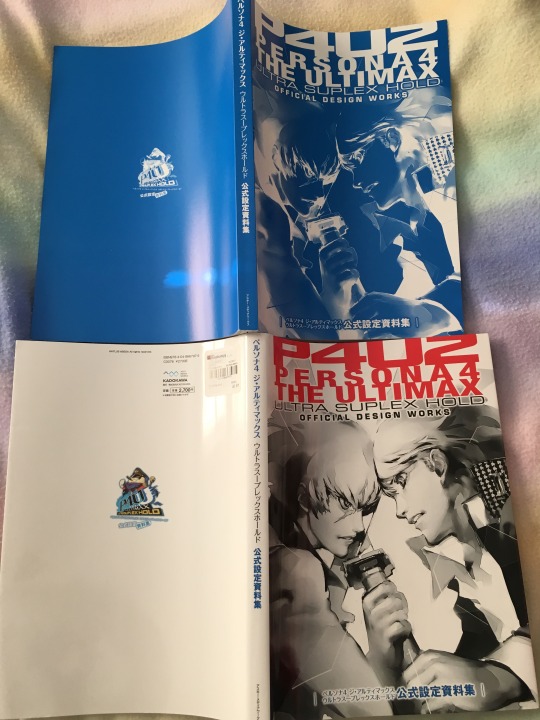
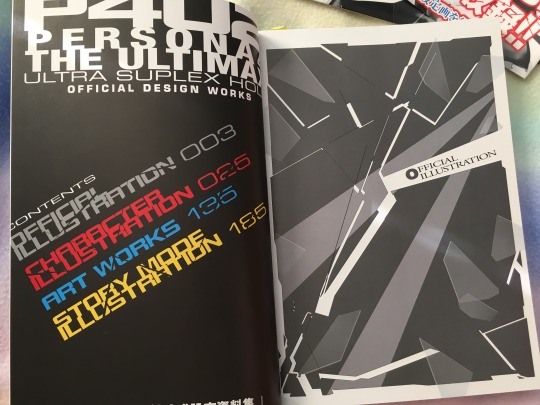
Also known as the “P4U2 (Persona 4 The Ultimax Ultra Suplex Hold) Official Design Works”!
Unlike the P4A/P4U solo art book that came before it, this art book does not have an official English translation, any creator interviews, or any sprite animation frames contained within it, so if you’re looking for any thoughts on the creative process behind Sho, the most you might find is in the ‘story movie’ storyboards section or Tsukiyomi’s prototype concept art. That said! I will break down what Sho-related content is actually included in this book.
Official Illustration
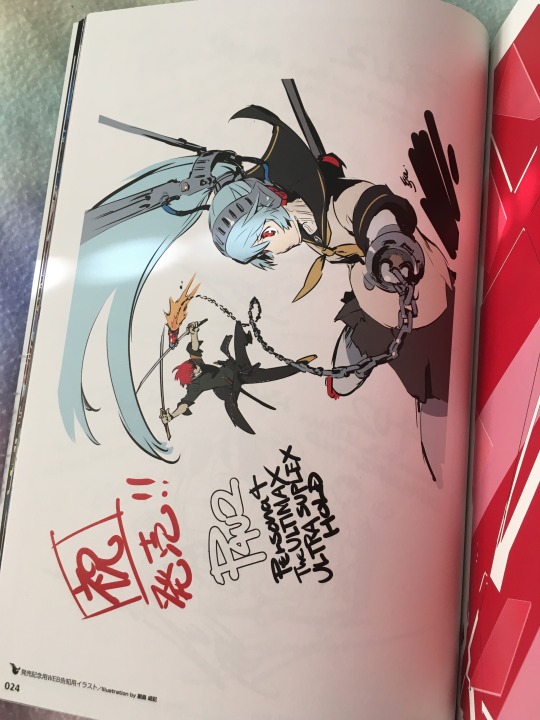
[The background art on the official website] by ドメリカ (maybe “domerica” the company? They appear to at least have worked on this game)
[The normal box art (sans logo)] by アトラス デ ザイン チ ー ム (Atlus Design Team)
[The Shadow version of the box art] by アトラス デ ザイン チ ー ム
[This Sho and Yu] piece by ドメリカ
The cover art piece, albeit in uncropped and textless form, by 副島 成記 (Soejima Shigenori)
[This fighting ring illustration] by アトラス デ ザイン チ ー ム
And the above image by 副島 成記
A thing to note! If the official illustrations are your top priority here, out of the Arena series art books, the cover image art (by Soejima) is only published in this book! It is NOT reprinted in the P4U x P4U2 Super Official Design Works. However, it was also collected in the more recent “Shigenori Soejima & P-Studio Art Unit: Art Works 2″ book alongside a lot of other Arena series illustrations at the very least (if there’s more places, I personally don’t know about them as I’m just a casual working with what I’ve got, not a collector xP). In addition, some of the illustrations here are reprinted in different formatting in the combined art book:
Is printed a little larger in the P4U2 art book than the P4U x P4U2 combined book, though that’s at the expense of the outer edges being somewhat cut-off for the former.
Is printed a little larger in the P4U2 art book than the P4U x P4U2 combined book. In the former, the outer-edges are a bit cut-off, while in the latter, the top and bottom are a bit cut-off instead.
Is printed a little larger in the P4U2 art book than the P4U x P4U2 combined book. In the former, the outer-edges are a bit cut-off, while in the latter, the top and bottom are a bit cut-off instead.
Is printed in a nearly full-page format in the P4U2 book (at the cost of a slight cut-off to the outer edges) versus the 3/4′s page in the combined art book.
Comparing this to the “Shigenori Soejima & P-Studio Art Unit: Art Works 2″ book instead of the P4U x P4U2 one; in this book, it was printed full-page on a single page, oriented landscape-wise instead of portrait-wise. In the Soejima & P-SAU one, it appears to be a two-page print, oriented portrait-style and printed somewhat larger (though the page divide cuts through the illustration as a result). (If you would like to see how it looks in the Soejima & P-SAU book, you can see it showcased a bit in this video here. If the timestamp link fails, it’s at around 3:30 in the video.)
Is printed a little larger in the this book than the combined one, but at the cost of a slight cut-off at the outer edges in the former. The colors are also printed a bit differently, and it has a white border in this book, while it has a black border in the combined art book.
Is printed in a full-page format with a white border in this book and a half-page format with a black border in the combined art book. There is no cut-off in the former.
Character Illustration

In the Character Illustration section, you will find pretty much any character art you can find in the game itself. This includes:
The arcade art, viewable from Gallery Mode in the game, for both Sho and Minazuki (as seen above on the left)
The “glasses/megane” variant of the arcade artwork in a smaller headshot format for both Sho and Minazuki
The official art for Tsukiyomi
The fighter profile/versus art for both Sho and Minazuki
The pre-combat (when you start an arcade run or something and see a character’s fighter tagline) graphics for both Sho and Minazuki (which you can also see a scan from this book of [here] if you’re curious how it looks!)
The Story Mode portraits for both Sho and Minazuki, as well as 6 expressions for each of them in a headshot format. Two of them are duplicated between Sho and Minazuki, and not all of their possible expressions are collected here (for example, Sho’s deliriously angry expression is missing from his set).
A shared ‘profile’ card for them both. It’s basically like the fighter info that shows up beneath a character on the Versus screen (so yes, it’s all “???”s like it is there), but with the addition of a “Weapon” and “Type”(for the weapon) category that does have a bit of non-”???” text. It basically just says that Sho and Minazuki use two katanas, and that I think Sho’s “type” is “body attack”, while Minazuki’s is “standard”, referring to Sho’s lack of Persona (thus using just his ‘body’ to attack) and Minazuki having a Persona like a “standard” fighter in the game?
Minazuki’s Insta-Kill cut-in
And Sho and Minazuki’s shared Awakening cut-in, as well as the glasses/megane version of it (which you can also see a scan from this book of [here] if you’re curious how it looks!)
Everything in this section is reprinted in the combined art book, albeit in different formatting:
The arcade art is actually printed a bit larger in the combined book than the solo one, but only Sho’s is printed in it. Minazuki’s gets relegated to a headshot alongside the glasses renditions of the art, which is zoomed in a bit more and framed by a circle instead of a square.
Is covered above
Tsukiyomi’s art is printed a little smaller in the combined book than the solo one, going from about a half-page to a third-page or a quarter-page
The versus portraits are actually only a smidge smaller in the combined art book than the solo one, and Minazuki’s arm doesn’t get cut off. The torsos for both Sho and Minazuki’s are a bit vertically cropped in the combined artbook however.
The pre-combat graphics are printed significantly smaller in the combined art book than the solo one, going from a 3/4ths page for Sho and a partially-obscured half-page for Minazuki to an equal quarter page for both, albeit Minazuki’s is no longer obscured as a result.
The story portraits go from about a quarter page in the solo book to a eighth-page or so for Sho (and a little smaller for Minazuki) in the combined book. There’s also a third portrait at the same size as Minazuki’s in the combined book showcasing their red-eyes default expression, which is only a headshot in the solo book. Aside from that, they share a pool of 10 total expression headshots in the combined book, some being labeled as exclusive Sho’s, some exclusively Minazuki’s, and some “common” which assumedly are shared by them both. They’re printed slightly bigger than the solo book’s and zoomed in a bit more, and include some of the expressions missing in the solo book (such as Sho’s wilder expressions). It’s still not a complete collection of every possible expression the two could make though; for example, Minazuki’s common ‘forlorn with closed eyes’(or however you’d describe that) isn’t included in the combined book, while it is in the solo book. Neither of them possess the version where Sho’s scar and eyes glow blue in the true ending though.
The “Profile” card is instead a “Personal Data” section in the combined art book, now with added “Star Sign”, “Blood Type”, and “Persona” categories, and also with English category names instead of Japanese (the actual answer text for each category is still in Japanese though). The only one that isn’t just “???”s out of those three is Persona, being answered with “Tsukiyomi (Minazuki)”.
The Insta-Kill cut-in is about the same size in both, although it’s filed under Sho and Minazuki’s section in the combined book instead of the general gallery for Insta-Kills in the solo book. It’s also slightly cropped in the solo book, whereas in the combined book it is not.
The Awakening cut-ins in the combined book are printed a little larger than in the solo one, but they’re also cropped narrower vertically than the solo one’s.
You can find pretty much all of the art in this section on the internet via a simple “Sho Minazuki” search as far as I’m aware, even the full range of Story Mode portrait expressions [here] (albeit you’ll have to do a bit of photo-editing to combine them into whole portraits). So if you just want to see that art outside of the game in general and not possess it specifically in art book form, then that’s very possible for you to do!
Art Works

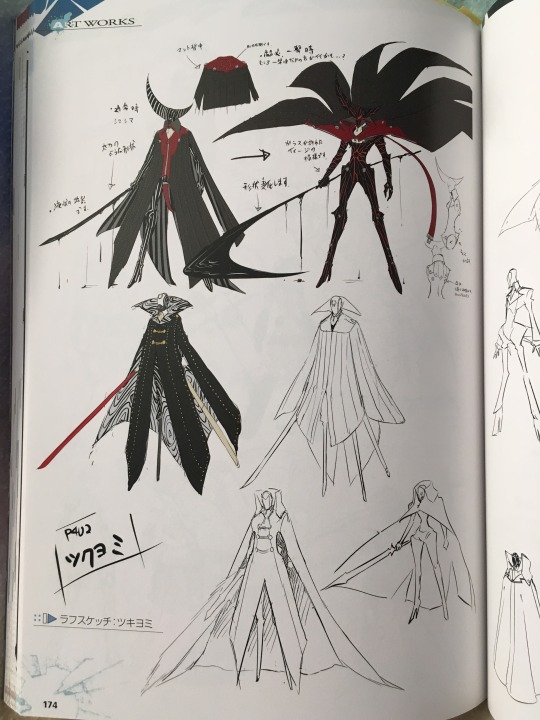

Hanging out in the Art Works section is basically a bunch of concept and technical art! For Sho in this section we’ve got:
Sho’s prototype designs, or as the book calls them, “rough sketch”es. (This also is the source of the camo coat that Sho is illustrated with in the Ultimax manga adaptation, I would guess.) (They’re pictured above, but if you’d like to see them in a clearer digital form, you can see them [here] and [here]!)
Tsukiyomi’s prototype designs (Also as pictured above.)
That’s pretty much it for Sho’s stuff in this section; a final total of 4 pages of content. A big thing to note though! Tsukiyomi’s prototype designs are NOT reprinted in the combined art book. Out of the 3 Arena-series artbooks, this is the only one it’s printed in. (I know, it’s kinda sad that you can’t just get all of Sho’s related concept art in one nice neat place. T-T So... I’m tentatively posting both of Tsuki’s pages here so other people might not have to deal with that issue.)
For the differences in printing for the Sho prototype designs though... The uncolored one with the little blobby dude is printed severely smaller in the combined book, being rendered as about an eighth-page or so as opposed to its full-page rendition in the solo book. The camo coat concept art is printed at about a third of the page in the combined book versus the half-page of the solo book, and the drawing with the two handed sword is roughly a quarter-page in the combined book versus the half page of the solo book.
Story Mode Illustration
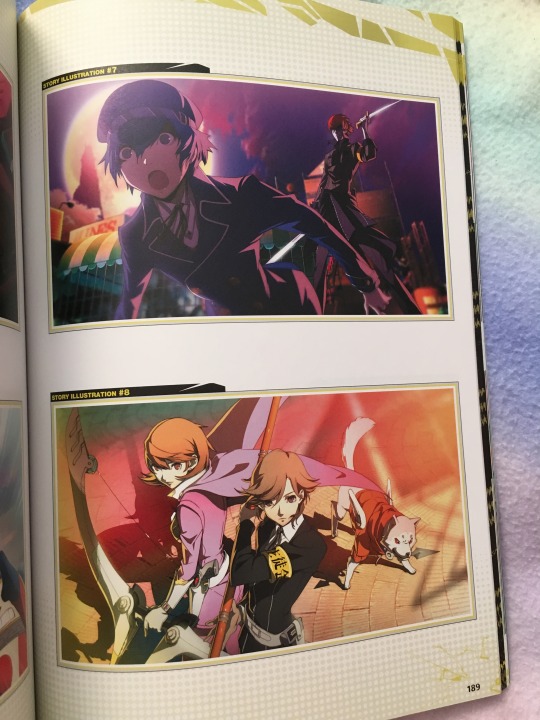
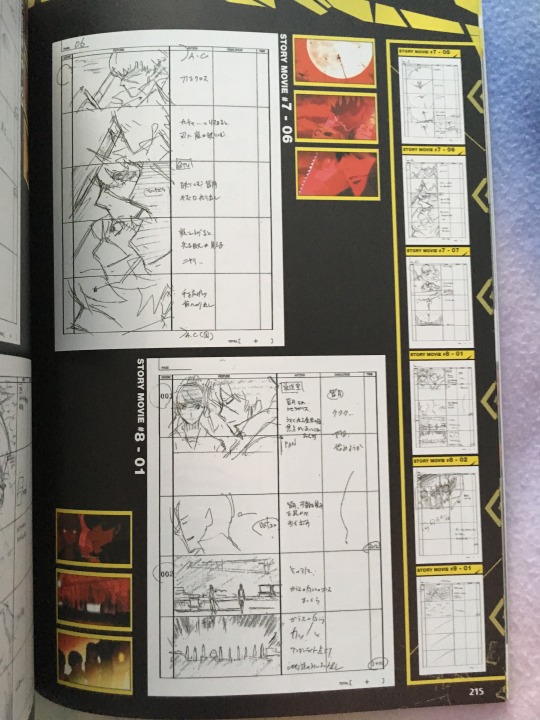
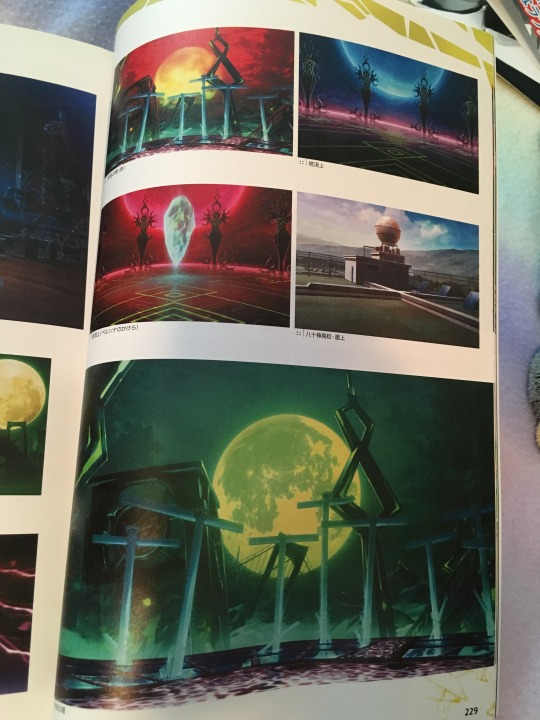
Lastly, we’ve got the section that collects some other pieces of art from the game, such as Story Mode illustrations, Story Mode background art, and then the storyboards for the various animated cutscenes that appear in the game as well. For the last one, it doesn’t really collect many frames from the finished animations in the book (to be precise, it has exactly 3 from each featured storyboard for some comparison between what that specific board covers and the corresponding final product, just not really any printed much bigger than a thumbnail’s size), just the animations’ collections of storyboards.
(Also note: I’m including the background art in this guide due to the fact some of it may hold a strong association with Sho and/or Minazuki for some people, and thus may potentially useful if people are looking for references or collections of them for Sho-related purposes.)
Story Mode Illustration:
(Note: Going by the numbers listed in the book, which should match up with the names they’re given in Gallery Mode in the game, as well as listing their channel numbers from Gallery Mode for reference.)
Story Illustration #7 (Channel 43; Minazuki sneak-attacking Naoto)
Story Illustration #10 (Channel 46; Yu, Chie, and Yosuke meet Minazuki... and Tsukiyomi)
Story Illustration #28 (Channel 64; Mitsuru gets a bleary look at Tsukiyomi)
Story Illustration #37 (Channel 73; Labrys, Yukari, Ken, and Junpei are about to battle Minazuki on the Moon Viewing Platform)
Story Illustrations #38 (Channel 74), #39 (Channel 75), #50 (Ep.Adachi DLC), #52 (Ep.Adachi DLC), and #53 (Ep.Adachi DLC) (or to specify them by details: the picture of General Teddie and Sho/Minazuki at the tower top, Sho facing away from Labrys in the TV Studio, Minazuki/Sho and Adachi on the Moon Viewing Platform just after the fog was summoned, Adachi and Sho facing each other down at the tower top, and Sho pummeling Adachi, respectively) are not included in this book. On top of that, the cut-in image of Minazuki’s sadistic grin on Illustration #37 is also wholly omitted from the book, for whatever reason.
For comparisons in formatting between this book and the P4U x P4U2 one:
#7 is printed at about a third-page size in this book and a large thumbnail size in the combined book, albeit laterally and vertically cropped in this book.
#10 is printed at about a third-page size in this book and.. I honestly don’t know the fraction on this one, but somewhat smaller in the combined book, and is very laterally and vertically cropped in this book.
#28 is printed at about a third-page size in this book and a large thumbnail size in the combined book. ...I can’t really tell if it’s cropped differently between the two due to the overall bleary and dark nature of the image. ^^;
#37 is printed at about a third-page size in this book and a large thumbnail size in the combined book, with Yukari’s arm (specifically) getting cut-off in the combined book but not this one. Beyond that, the Minazuki cut-in portion actually is technically printed in the combined book, but only as a small fractal piece of the background on the Sho and Minazuki profile page (which will be pictured in my P4U x P4U2 artbook post).
#38 is actually printed in the combined art book at least, at about a third-page size.
#39, #50, #52, and #53 are not printed in the combined book either. It is a very sad day that I’ve come to realize this. T^T
So the final verdict is that if you’re looking for Story Mode illustrations of Sho Minazuki, this art book only has less than half of the total ones he’s depicted in from the game.
Movie Story Board:
Opening Movie (Channel 90; the one that plays before you get to the title screen/the one the short version of “Break Out Of...” plays for): all boards (01-29), with boards 04, 05, 08, 11, 14, 18, 20, 24, 26, and 27 being featured. Out of those, Sho appears in boards 04, 23, 24, and 25.
Story Movie #1 (Channel 91; Yu watches the red fog hit Inaba at the start of EpP4): all boards (01-32), though the only one that matters here is board 26, as Sho is set to briefly appear on the TV during the countdown. It is not a featured board.
Story Movie #5 (Channel 95; Sho’s introduction to Yu, Yosuke, and Chie in EpP4): all boards (01-03), with board 02 being featured. Sho appears on all three boards.
Story Movie #7 (Channel 97; the giant backflip.. tower version, not the town version found in some Arcade Mode runs, though only the background really changes if memory serves): all boards (01-07) with boards 04 and 06 being featured. Board 01 is just debris falling, so Sho appears in 02-07.
Story Movie #8 (Channel 98; Minazuki activates the Shadow clones): all boards (01-02), with board 01 being featured. Minazuki only appears in 01, as 02 is a just a shot of the clones ‘coming alive’.
Story Movie #9 (Channel 99; the limo goes off the road): all boards (01-14), with boards 02, 05, 10, and 12 being featured. Sho appears only in board 12.
There appears to be no boards for Story Movies #12 (Channel 104; Kagu-possessed Sho is devoured by Kagu’s new body) or #14 (Channel 106; Sho in the ‘true’ ending when the tower top is all blue) in this book, but they are somewhat collected in the combined artbook! As for the differences, the combined artbook only collects some of the boards at kind of random, but prints them at sizes somewhere between the featured boards and the tinier side-page boards. Alongside that, there’s little captions for each Movie, with two specifically for the Opening Movie, while all of the rest only get one each. The boards it collects for each Movie are:
Opening Movie: 02, 03, 04, 05, 06, 08, 09; 23, 24, 25, 26, and 27
Story Movie #1: board 26 is included
Story Movie #5: 02 & 03
Story Movie #7: 05 & 06
Story Movie #8: 01 & 02
Story Movie #9: board 12 is not included
Story Movie #12: 06 & 07 (06 showcases Sho.. he’s kinda nommed by 07)
Story Movie #14: 02 & 05 (neither of them showcase Sho)
So overall, depending on what you’re looking for out of the animation storyboards, one book might be better over the other, given they both possess some things that the other does not.
Background Illustration:
Pretty much any background art you see in the game is collected here, I believe, though I haven’t comprehensively combed through both the book and the game in their entirety to check the utmost-thoroughly. I have my limits of tedium I’m willing to go to for this stuff, so I apologize. xP
All of the backgrounds art in this book are either formatted as half-page or eighth-page size, with there being one half-page and 4 eighth-pages per full page. ...I’m not going to go through and transcribe-to-translate 65 different Japanese titles for the 65 different backgrounds included in this book so I can properly list the ones likely to be most relevant to Sho, but at least I can verify that I see art from both main routes, their epilogues, the ‘true’ ending of EpP4, and a couple specifically from EpAdachi.
As for the formatting in the combined artbook, the art is significantly smaller, with the biggest being sized around an eighth-page, the middle-size being like an elongated medium-sized thumbnail, and the smallest being like an actual medium-sized thumbnail, scattered around the page much more haphazardly. (The difference will probably be visible when I post the combined art book’s guide. ^^;)
Again, I’m not going as specifically through this part due to lack of concrete names to use, so there may be variances in which version of the background is collected, or some being omitted or gained potentially?
I haven’t ever tried looking up the Story Mode backgrounds on the internet before, so I’m afraid I can’t say how much luck you might be able to have looking for them on the internet versus the books. ^^;
Concluding Notes:
And that’s everything in this book! More or less it’s kind of got the feel of an art gallery in book form to it (which the super-vivid printing of the colors really helps-- it looks really pretty in-person, which the camera kind of picked up), I think, which the combined art book doesn’t quite match, but also lacks a lot of the concept and technical art for Sho that the combined artbook does have.
If you’re looking to get a copy of your own, I recommend checking Mercari or Ebay! I’m not sure if there’s other sites out there that have it or not, since I found my own copies on those, but you can try looking under both the Japanese version of the title (both in Japanese characters and in Latin characters) and the English one in general search engines or various other sites if you wish, or else perhaps sites like Amazon Japan or Rakuten (Japan?) if you’re trying to find a digital copy?
The guide for the P4U x P4U2 Super Official Design Works will come eventually! In the meantime, if you want to get an idea of some of what it possesses in terms of Sho content, I have a post [here] with a few pictures.
Also, if anyone knows something more than I do about anything I wrote here, please feel free to correct me! Nicely, of course, and preferably with an accurate source to cite, but despite being a casual I’d much prefer to have accurate info in these whenever possible.
#Capri's guide to finding Sho Minazuki content#Sho Minazuki#ミナヅキショウ#皆月 翔#Tsukiyomi (Persona)#ツキヨミ (ペルソナ)#P4U2#P4AU#Persona 4 Arena Ultimax#Persona 4 The Ultimax Ultra Suplex Hold#ペルソナ4 ジ・アルティマックス ウルトラス―プレックスホールド#Persona 4 Arena Ultimax artbook#P4U2 Official Design Works#Tsukiyomi prototype designs#ミナヅキ ショウ
18 notes
·
View notes